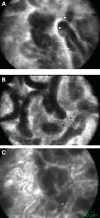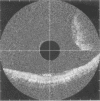Optical endomicroscopy and the road to real-time, in vivo pathology: present and future
- PMID: 22889003
- PMCID: PMC3502368
- DOI: 10.1186/1746-1596-7-98
Optical endomicroscopy and the road to real-time, in vivo pathology: present and future
Abstract
Epithelial cancers account for substantial mortality and are an important public health concern. With the need for earlier detection and treatment of these malignancies, the ability to accurately detect precancerous lesions has an increasingly important role in controlling cancer incidence and mortality. New optical technologies are capable of identifying early pathology in tissues or organs in which cancer is known to develop through stages of dysplasia, including the esophagus, colon, pancreas, liver, bladder, and cervix. These diagnostic imaging advances, together as a field known as optical endomicroscopy, are based on confocal microscopy, spectroscopy-based imaging, and optical coherence tomography (OCT), and function as "optical biopsies," enabling tissue pathology to be imaged in situ and in real time without the need to excise and process specimens as in conventional biopsy and histopathology. Optical biopsy techniques can acquire high-resolution, cross-sectional images of tissue structure on the micron scale through the use of endoscopes, catheters, laparoscopes, and needles. Since the inception of these technologies, dramatic technological advances in accuracy, speed, and functionality have been realized. The current paradigm of optical biopsy, or single-area, point-based images, is slowly shifting to more comprehensive microscopy of larger tracts of mucosa. With the development of Fourier-domain OCT, also known as optical frequency domain imaging or, more recently, volumetric laser endomicroscopy, comprehensive surveillance of the entire distal esophagus is now achievable at speeds that were not possible with conventional OCT technologies. Optical diagnostic technologies are emerging as clinically useful tools with the potential to set a new standard for real-time diagnosis. New imaging techniques enable visualization of high-resolution, cross-sectional images and offer the opportunity to guide biopsy, allowing maximal diagnostic yields and appropriate staging without the limitations and risks inherent with current random biopsy protocols. However, the ability of these techniques to achieve widespread adoption in clinical practice depends on future research designed to improve accuracy and allow real-time data transmission and storage, thereby linking pathology to the treating physician. These imaging advances are expected to eventually offer a see-and-treat paradigm, leading to improved patient care and potential cost reduction.
Virtual slides: The virtual slide(s) for this article can be found here: http://www.diagnosticpathology.diagnomx.eu/vs/5372548637202968.
Figures











Similar articles
-
New optical imaging technologies for bladder cancer: considerations and perspectives.J Urol. 2012 Aug;188(2):361-8. doi: 10.1016/j.juro.2012.03.127. Epub 2012 Jun 13. J Urol. 2012. PMID: 22698620 Free PMC article. Review.
-
Emerging enhanced imaging technologies of the esophagus: spectroscopy, confocal laser endomicroscopy, and optical coherence tomography.J Surg Res. 2015 May 15;195(2):502-14. doi: 10.1016/j.jss.2015.02.045. Epub 2015 Feb 21. J Surg Res. 2015. PMID: 25819772 Review.
-
Confocal Laser Endomicroscopy and Optical Coherence Tomography for the Diagnosis of Prostate Cancer: A Needle-Based, In Vivo Feasibility Study Protocol (IDEAL Phase 2A).JMIR Res Protoc. 2018 May 21;7(5):e132. doi: 10.2196/resprot.9813. JMIR Res Protoc. 2018. PMID: 29784633 Free PMC article.
-
Advanced Endoluminal Technologies for Barrett's Esophagus: Focus on Optical Coherence Tomography and Confocal Laser Endomicroscopy.Thorac Surg Clin. 2018 Nov;28(4):465-472. doi: 10.1016/j.thorsurg.2018.07.012. Thorac Surg Clin. 2018. PMID: 30268292 Review.
-
Optical frequency domain imaging of ex vivo pulmonary resection specimens: obtaining one to one image to histopathology correlation.J Vis Exp. 2013 Jan 22;(71):3855. doi: 10.3791/3855. J Vis Exp. 2013. PMID: 23381470 Free PMC article.
Cited by
-
CAESNet: Convolutional AutoEncoder based Semi-supervised Network for improving multiclass classification of endomicroscopic images.J Am Med Inform Assoc. 2019 Nov 1;26(11):1286-1296. doi: 10.1093/jamia/ocz089. J Am Med Inform Assoc. 2019. PMID: 31260038 Free PMC article.
-
Diagnostic accuracy of optical coherence tomography in bladder cancer patients: A systematic review and meta-analysis.Mol Clin Oncol. 2018 Apr;8(4):603-608. doi: 10.3892/mco.2018.1566. Epub 2018 Feb 2. Mol Clin Oncol. 2018. PMID: 29541471 Free PMC article.
-
Gastrointestinal diagnosis using non-white light imaging capsule endoscopy.Nat Rev Gastroenterol Hepatol. 2019 Jul;16(7):429-447. doi: 10.1038/s41575-019-0140-z. Nat Rev Gastroenterol Hepatol. 2019. PMID: 30988520 Review.
-
Miniature forward-imaging B-scan optical coherence tomography probe to guide real-time laser ablation.Lasers Surg Med. 2014 Mar;46(3):193-202. doi: 10.1002/lsm.22214. Lasers Surg Med. 2014. PMID: 24648326 Free PMC article.
-
Preliminary study of confocal laser endomicroscopy for in vitro specimens of the endometrium.BMC Cancer. 2022 Oct 25;22(1):1094. doi: 10.1186/s12885-022-10137-x. BMC Cancer. 2022. PMID: 36284282 Free PMC article.
References
Publication types
MeSH terms
LinkOut - more resources
Full Text Sources

